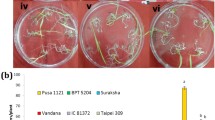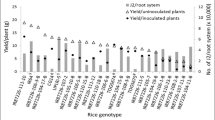Abstract
Meloidogyne incognita causes huge yield losses in rice which is the third most important cereal crop in Kenya. The aim of this study was to identify M. incognita-resistant rice cultivars from Kenya and relate the responses to known resistance pathways with OsPR1a, OsPAL1, and OsJAMYB as marker genes in rice. Five rice cultivars BW 196, Basmati 217 (Pishori), Sindano, IR 2793-80-1 (grown in lowland irrigated fields), and NERICA 4 (grown in upland rainfed fields) were evaluated for resistance to M. incognita under greenhouse conditions in two separate trials. The number of nematode eggs, reproduction factor (RF), and the level of galling were determined. The RF was used to select resistant cultivars. There was a significant difference (P < 0.001) in the number of eggs, galling index, and RF among the cultivars. NERICA 4, BW 196, and Sindano were classified as resistant with an RF <1. There was differential expression of the three marker genes between susceptible and resistant cultivars. OsJAMYB gene was up-regulated in leaves of all rice cultivars after 1 and 3 days post inoculation (dpi). OsPAL1 was up-regulated in leaves of all varieties at 3 dpi while OsPR1a was down-regulated in leaves of resistant plants at 1 dpi and 3 dpi. These results provide an insight on sources of M. incognita resistance in Kenyan rice and it also forms an interesting starting point for further studies on defense responses of common rice varieties to root knot nematode infection.
Similar content being viewed by others
Abbreviations
- dpi:
-
days post inoculation
- GI:
-
Galling index
- J2s:
-
Second stage juveniles
- KALRO:
-
Kenya Agricultural and Livestock Research Organization
- Pf:
-
Final population
- Pi:
-
Initial population
- RF:
-
Reproduction factor
- RKN:
-
Root knot nematodes
References
Adeyemo AC, Ashamo MO, Odeyemi OO. 2015. Screening of selected properties of some paddy rice varieties for their resistance against Sitotroga cerealella attack in storage. Futa J. Res. Sci. 2: 210–216
Barcala M, Garcia A, Cabrera J, Casson S, Lindsey K, Favery B, Garcia-Casado G, Solano R, Fenoll C, Escobar C. 2010. Early transcriptomic events in microdissected Arabidopsis nematode-induced giant cells. Plant J. 61: 698–712
Bimpong IK, Carpena AL, Mendioro MS, Fernandez L, Ramos J, Reversat G, Brar DS (2010) Evaluation of Oryza sativa x O. glaberrima derived progenies for resistance to rootknot nematode and identification of introgressed alien chromosome segments using SSR markers. Afr. J. Biotechnol. 9: 3988–3997
Cabasan M, Kumar A, Bellafiore SB, De Waele D, 2014, Histopathology of the rice root-knot nematode, Meloidogyne graminicola, on Oryza sativa and O. glaberrima. Nematology 16: 73–81
Cabasan MT, Kumar A, De Waele D. 2012. Comparison of migration, penetration, development and reproduction of Meloidogyne graminicola on susceptible and resistant rice genotypes. Nematology 14: 405–415
De Waele DD, Das K, Zhao D, Tiwari R, Shrivastava DK, Vera-Cruz C, Kumar A. 2013. Host response of rice genotypes to the rice root-knot nematode (Meloidogyne graminicola) under aerobic soil conditions. Arch. Phytopathol. 46: 670–681
De Waele D, Elsen A. 2007. Challenges in Tropical Plant Nematology. Annu. Rev. Phytopathol. 45: 457–485
Dimkpa SON, Lahari Z, Shrestha R, Douglas A, Gheysen G, Price AH. 2016. A genome-wide association study of a global rice panel reveals resistance in Oryza sativa to root-knot nematodes. J. Exp. Bot. 67: 1191–1200
Dong W, Holbrook CC, Timper P, Brenneman TB, Mullinix BG. 2007. Comparison of methods for assessing resistance to Meloidogyne arenaria in peanut. J. Nematol. 39: 169–175
Fernandez L, Cabasan MTN, De Waele D. 2014. Life cycle of the rice rootknot nematode Meloidogyne graminicola at different temperatures under non-flooded and flooded conditions. Arch. Phytopathol. Plant Prot. 47: 1042–1049
Gheysen G, Mitchum M. 2011. How nematodes manipulate plant development pathways for infection. Curr. Opin. Plant Biol. 14: 415–421
Glazebrook J. 2005. Contrasting mechanisms of defense against biotrophic and necrotrophic pathogens. Annu. Rev. Phytopathol 43: 205–227
Holbrooks CC, Noe JP. 1992. Resistance to the peanut Root-Knot Nematode (Meloidogyne arenaria) in Arachis hypogaea. Peanut Sci. 19:35–37
Ji H, Gheysen G, Denil S, Lindsey K, Topping JF, Nahar K, Haegeman A, Vos WH De, Trooskens G, Criekinge W Van, Meyer T De, Kyndt T. 2013. Transcriptional analysis through RNA sequencing of giant cells induced by Meloidogyne graminicola in rice roots. J. Exp. Bot. 64: 3885–3898
Kumari C, Dutta TK, Banakar P, Rao U. 2016. Comparing the defence-related gene expression changes upon root-knot nematode attack in susceptible versus resistant cultivars of rice. Sci. Rep. 6: 1–13
Kyndt T, Denil S, Haegeman A, Trooskens G, Bauters L, Criekinge W, Meyer TD, Gheysen G. 2012a. Transcriptional reprogramming by root knot and migratory nematode infection in rice. New Phytol. 196: 887–900
Kyndt T, Nahar K, Haegeman A, De Vleesschauwer D, Hofte M, Gheysen G. 2012b. Comparing the defence-related gene expression changes upon migratory and sedentary nematode attack in rice. Plant Biol. 14: 73–82
Lee M, Qi M, Yang Y. 2001. A novel jasmonic acid-inducible rice myb gene associates with fungal infection and host cell death. MPMI 14: 527–535
MOA. 2008. Ministry of Agriculture, National rice development strategy (2008-2018). Available from, http://www.jica.go.jp. Accessed 20th May 2017
MOALF. 2016. Roadmap for Rice Seed Development Republic of Kenya. Available from, http://www.riceforafrica.net. Accessed 10th May 2017
Mogga ML, Lamo J, Asea G, Gibson P, Edema R. 2012. Reaction of rice cultivars to a virulent rice yellow mottle virus strain in Uganda. Afr. Crop Sci. J 20: 51–57
Molinari S, Fanelli E, Leonetti P. 2014. Expression of tomato salicylic SA-responsive pathogenesis-related genes in Mi-1-mediated and SA-induced resistance to root-knot nematodes. Mol. Plant Pathol. 15: 255–264
Mullin BA, Abawi GS, Pastor-Corrales MA. 1991. Modification of resistance expression of Phaseolus vulgaris to Meloidogyne incognita by elevated soil temperatures. J. Nematol. 23: 182–187
Nahar K, Yndt T, Vleesschauwer D De, Hofte M, Gheysen G. 2011- The Jasmonate pathway is a key player in systemically induced defense against Root Knot Nematodes in rice. Plant Pathol 157: 305–316
Norusis M. 1995. SPSS 6.1 Guide to Data Analysis. Prentice Hall, Englewood Cliffs
Oostenbrink M. 1966. Major characteristics of the relation between nematodes and plants. Mededelingen Van de landbouwhogeschool te wageningen, Nederland, 66: 1–46
Patil J, Gaur HS. 2014. The effect of root-knot nematode, Meloidogyne graminicola, on the quality and vigour of rice seed. Nematology 16: 555–564
Petitot A, Kyndt T, Haidar R, Dereeper A, Collin M, Engler JDA, Gheysen G, Fernandez D. 2017. Transcriptomic and histological responses of African rice (Oryza glaberrima) to Meloidogyne graminicola provide new insights into root-knot nematode resistance in monocots. Ann. Bot. 119: 885–899
Pieterse CM, Leon-Reyes A, Van der Ent S, Van Wees SC. 2009. Networking by small-molecule hormones in plant immunity. Nat. Chem. Biol. 5: 308–316
Pokharel RR, Duxbury JM, Abawi GS. 2012. Evaluation of protocol for assessing the reaction of rice and wheat germplasm to infection by Meloidogyne graminicola. J. Nematol. 44: 274–283
Prot JC, Matias DM. 1995. Effects of water regime on the distribution of Meloidogyne graminicola and other root parasitic nematode in a rice field toposequence and pathogenicity of M. graminicola on rice cultivar UPLR 15. Nematologica 41: 219–228
Rosso MN, Hussey R, Davis EL, Smant G, Baum T, Abad P, Mitchum M. 2012. Nematode effectors protein: Targets and functions in plant parasitism. In: F Martin, S Kamoun, eds, Effectors in Plant-Microbe Interactions, Wiley-Blacwell, Oxford, UK. pp 327–354
Shrestha R, Uzzo F, Wilson MJ, Price AH. 2007. Physiological and genetic mapping study of tolerance to root-knot nematode in rice. New Phytol. 176: 665–672
Soriano IRS, Prot J, Matias DM. 2000. Expression of tolerance for Meloidogyne graminicola in rice cultivars as affected by soil type and flooding. J.Nematol. 32: 309–317
Soriano IR, Schmit V, Brar DS, Prot J, Reversat G. 1999. Resistance to rice root-knot nematode Meloidogyne graminicola identified in Oryza longistaminata and O. glaberrima. Nematology 1: 395–398
Souza DCT, Botelho FB, Rodrigues CS, Furtini IV, Smiderle EC, Matos DL, De Bruzi AT. 2015. Resistance of upland-rice lines to root-knot nematode, Meloidogyne incognita. Genetics and Molecular research, 14: 17384–17390
Tandingan IC, Prot JC, Davide RG. 1996. Influence of water management on tolerance of rice cultivars for Meloidogyne graminicola. Fundam. Appl. Nematol. 19: 189–192
Williamson VM. 1998. Root-knot nematode resistance genes in tomato and their potential for future use. Annu. Rev. Phytopathol. 36: 277–293
Win PP, Kyi PP, De Waele D. 2011. Effect of agro-ecosystem on the occurrence of the rice root-knot nematode Meloidogyne graminicola on rice in Myanmar. Aust. Plant Pathol. 40: 187–196
Win PP, Kyi PP, Thu Z, Maung Z, Myint YY, De Waele D. 2015. Comparison of the damage potential and yield loss of the rice root-knot nematode, Meloidogyne graminicola, on lowland and upland rice varieties from Myanmar. Russ. J. Nematol. 23: 53–72
Zhou E, Wheeler T, Starr JL. 2000. Root galling and reproduction of Meloidogyne incognita isolates from Texas on resistant cotton genotypes. Suppl. J. Nematol. 32: 513–518
Author information
Authors and Affiliations
Corresponding author
Rights and permissions
About this article
Cite this article
Namu, J., Alakonya, A., Karuri, H. et al. Response of Selected Kenyan Rice Cultivars to Infection by Root Knot Nematode (Meloidogyne incognita). J. Crop Sci. Biotechnol. 22, 47–54 (2019). https://doi.org/10.1007/s12892-017-0101-0
Received:
Revised:
Accepted:
Published:
Issue Date:
DOI: https://doi.org/10.1007/s12892-017-0101-0




